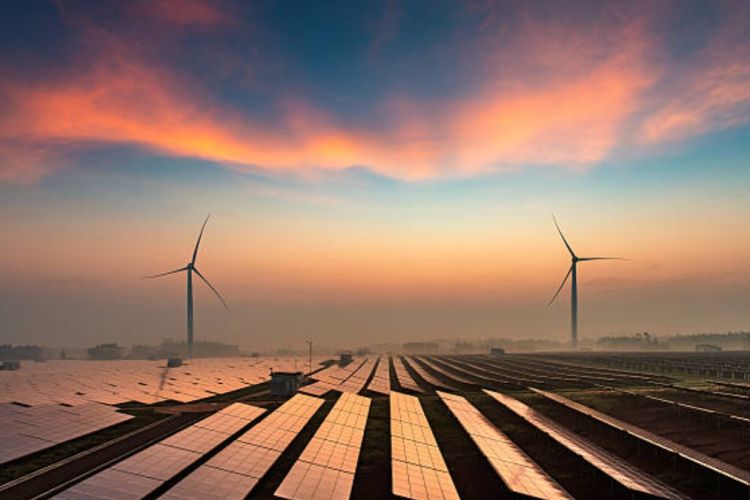
India’s clean energy transition: Energy is not only the foundation of economic development, it is the lifeblood of a nation’s aspirations. It powers factories and farms, moves people and ideas, and anchors dignity within every household. Where access is absent, growth falters and inequality deepens, leaving entire communities locked out of opportunity. For India, securing universal, affordable and sustainable energy is more than a policy target. It is a moral commitment to inclusive prosperity and a defining test of its development model. How India meets this challenge will not only shape its own economic rise but also offer a template for the wider developing world.
The growing digitalisation of the economy provides a transformative lever to this mission by improving efficiency, optimising consumption and extending clean power to the last mile. Today, India’s energy demand is not just rising, it is also reshaping itself. Electricity demand has surged by more than 20 percent over the past three years and nearly doubled in the last decade, with peaks now occurring in the afternoon and late evening rather than mid-day and early evening.
READ | Gaza famine puts Israel in a strategic bind
Residential and commercial sectors together account for nearly 45 percent of demand, and soaring air-conditioner use alone could add as much as 120 to 140 gigawatts to peak load by 2030—greater than the entire electricity demand of the United Kingdom. Industry too is a heavy consumer, accounting for 38 percent of energy use and 40 percent of emissions. These shifts underscore that India’s transition is about managing a far more complex demand profile.
India’s clean energy ambition is known and part of actual on-ground delivery. With a declared target of 500 gigawatts of non-fossil fuel capacity by 2030, the country has signalled intent at a scale few emerging economies can match. Yet, the credibility of this transition will not be judged by installed capacity alone. It will be tested by the sophistication of governance that underpins it.
The first test of reform
The first reform imperative is regulatory coherence. India’s energy governance is splintered across ministries, regulators and state utilities. This fragmentation produces policy uncertainty, delayed payments to developers and frequent contract disputes. Without decisive restructuring, investment will remain cautious. A unified national regulator with binding authority over tariffs, contracts and dispute resolution is essential. Predictable regulation must become the anchor of India’s energy strategy.
Predictability must also extend to forecasting. Renewable power is inherently volatile, and accurate forecasting is as central to energy planning as fiscal discipline is to macroeconomics. India’s meteorological systems still function at scales that fail to match grids operating on fifteen-minute cycles. The Central Electricity Authority has called for ultra-local forecasts and predictive modelling to guide grid operations and infrastructure investment. Without such precision, every new megawatt of renewable energy risks undermining grid stability rather than strengthening it.
Equally important is the recognition that India is entering what might be called a “quick-commerce era” of electricity. Grids must respond in real time, as demand fluctuates minute to minute. Traditional long-term power purchase agreements, while useful, are under strain in this context. At the same time, the government is pioneering new regulatory models: four high-emitting sectors—aluminium, cement, chlor-alkali and pulp and paper—are now subject to annual emissions intensity targets, enabling carbon pricing to guide corporate decision-making. These innovations reflect the agility governance must embrace: building flexible markets while enforcing emissions discipline.
Financing clean energy transition
The second imperative is financial restructuring. Distribution companies remain the weakest link in the chain, with losses that erode their ability to procure renewable power. Unless discoms are restructured through professional management, cost-reflective tariffs and direct benefit transfers that shield vulnerable consumers, they will continue to slow adoption. At the same time, India must institutionalise-at-scale sovereign green funds and blended finance mechanisms that attract patient global capital and lower cost of debt. The success of the transition rests as much on financial engineering as on technological adoption.
Capacity growth also needs to align with demand. Over forty gigawatts of renewable capacity currently lack buyers because supply agreements were not secured in time. This mismatch between generation and demand signals a governance failure. Developers, regulators and transmission planners must be locked into coordinated frameworks that ensure offtake agreements and transmission requests are secured years ahead of project commissioning. Without such discipline, India risks building stranded assets that erode investor confidence.
The third reform imperative is land and community integration. Solar parks and wind farms demand vast tracts of land, leading to disputes with farmers, delays in environmental clearances and local resistance. A national land-use framework that earmarks renewable zones with pre-cleared approvals would reduce friction. Equally important is shifting from one-time compensation to long-term revenue-sharing with communities. Only by making local stakeholders beneficiaries rather than bystanders can India secure legitimacy for its transition.
The fourth imperative is transmission infrastructure. Renewable-rich states such as Rajasthan, Gujarat and Tamil Nadu are already facing curtailments because the interstate grid cannot evacuate the power generated. A statutory independent transmission authority must be mandated to anticipate renewable corridors and build capacity ahead of demand. Transmission planning should evolve from reactive approvals to forward-looking capacity investment, with accountability for execution timelines.
The fifth priority is supply chain resilience. India’s dependence on imported modules, batteries and electrolyzers leaves it exposed to global shocks. The Production Linked Incentive scheme has triggered a new wave of manufacturing, yet backward integration into polysilicon, wafers and critical minerals remains shallow. Strategic international partnerships for lithium, cobalt and nickel supply must be forged, with a clear roadmap to achieve at least fifty percent domestic value addition in clean energy manufacturing by 2030.
Finance and storage are now the pressure points. Coal’s share in the power mix has dipped below half for the first time, with thirty gigawatts of renewables added in a single fiscal year—enough to power eighteen million homes. Yet, India faces a looming storage deficit. Over 330 gigawatt-hours of storage will be needed by 2030, but current projections suggest less than a third of that will be available. Unless governance frameworks incentivise coordinated investment in storage, manufacturing and mineral supply chains, the transition will slow at its most critical hinge point.
The future of clean energy
Equally important is digitalisation. The future of India’s energy system will not be defined by grid-scale projects alone. Distributed renewables, smart grids, artificial intelligence-driven demand response and predictive maintenance are already reshaping energy systems worldwide. These innovations demand a regulatory ecosystem that incentivises integration, protects prosumers and guarantees cybersecurity. Governance that lags behind digital innovation risks constraining the very tools that could accelerate the transition.
India’s clean energy transition is both a governance test and a nation-building project. Smart-governance therefore is not an abstraction. It requires a governance architecture that enforces regulatory discipline, delivers financial innovation, integrates local communities, builds resilient supply chains, expands storage and embraces digitalisation.
Srinath Sridharan is a strategic counsel with 25 years experience with leading corporates across diverse sectors including automobiles, e-commerce, advertising and financial services. He understands and ideates on intersection of finance, digital, contextual-finance, consumer, mobility, Urban transformation, and ESG. Actively engaged across growth policy conversations and public policy issues.

